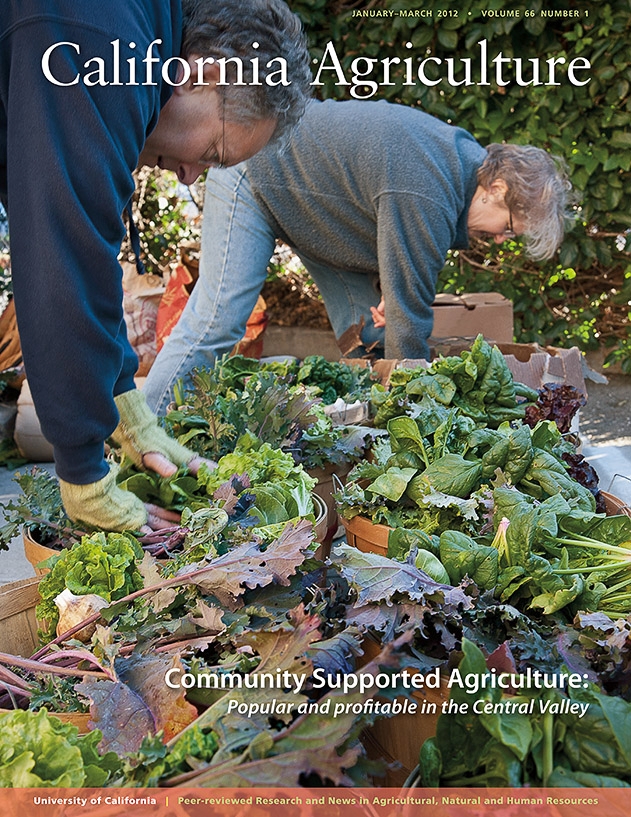
Total membership in the CSAs surveyed (n = 46) increased exponentially from an estimated 672 members in 1990 to 32,938 members in 2010. Most CSAs in California’s Central Valley and surrounding foothills were relatively small (20 acres on average), produced a broad range of crops (44 on average) and adhered to organic or sustainable growing practices.
Likewise, 54 percent of the CSA farms surveyed were profitable; of the rest, 32 percent broke even and 15 percent operated at a loss. Gross average sales for the CSAs surveyed were $9,084 per acre in 2009; this compares with average gross sales of $1,336 per acre for California agriculture in general.
Despite their increasing popularity, little is known about CSA farmers and their operations. UC researchers conducted a comprehensive study of CSA farmers in the Central Valley and surrounding foothills about their growing practices, farm economics, demographics and other characteristics. The article in full and the entire January–March 2012 issue of California Agriculture can be found at: http://californiaagriculture.ucanr.org.
CSAs eliminate distributors, forging direct connections between farmers and consumers; California has about 275 CSAs, and there are more than 3,500 nationally. The researchers found that CSAs are adapting and changing to meet consumer interest in and demand for locally produced food.
“Together with farmers markets, farm stands, U-picks and agritourism, CSAs constitute a ‘civic agriculture’ that is re-embedding agricultural production in more sustainable social and ecological relationships, maintaining economic viability for small- and medium-scale farmers and fulfilling the non–farm-based population's increasing desire to reconnect with their food,” Ryan Galt, UC Davis assistant professor in the Department of Human and Community Development, and co-authors wrote in California Agriculture journal.
The CSA model has undergone considerable change and innovation, the researchers found, with growers offering new products such as meat and dairy and making payment options more attractive to consumers. When the first CSAs were started on the East Coast in the mid-1980s, members paid in advance and received a share of the farm’s crop in return, and they also shared in production risks. Today’s CSAs allow consumers more flexibility and less risk. “Twenty percent of CSAs in the study had no minimum payment period, allowing week-by-week payments, which extends membership to a broader population, including those hesitant or unable to commit to extended payments,” the authors wrote.
The study team also interviewed CSA farmers about what motivated them. “Even though a CSA is hard work, farmers tend to find it rewarding,” Galt and co-authors noted. “The vast majority were happy with their work and continued to view the CSA as a viable option for small- and medium-scale farmers.”
Also in the January–March 2012 issue of California Agriculture:
Farm-to-WIC study: The federal Special Supplemental Nutrition Program for Women, Infants and Children (WIC) now distributes monthly cash vouchers to low-income women with children to buy fruits and vegetables. UC Cooperative Extension (UCCE) researchers surveyed WIC participants in Tulare, Alameda and Riverside counties in 2010 to guide the development of a farm-to-WIC program that would connect local growers to the WIC market. Based on WIC participants’ produce preferences and buying habits, they developed a list of 19 produce items for possible inclusion in the program, including broccoli, cabbage, collards, nopales, sweet potato and tomatillo.
Preventing Fusarium wilt of lettuce: Caused by the soilborne fungus Fusarium oxysporum f. sp. lactucae, Fusarium wilt affects all major lettuce production areas in California and Arizona. In trials at UC Davis, lettuce cultivars differed significantly in susceptibility to the disease, with some leaf and romaine types highly resistant under all test conditions. Management of Fusarium wilt requires an integrated approach that includes crop rotation to reduce soil inoculum levels and the use of resistant cultivars during the warmest planting windows.
Also in the online-only E-Edition of California Agriculture:
Biological control for citrus pests: In a spring 2010 survey and statistical analysis, growers with greater citrus acreage and more education were more likely to use biological controls for four important citrus pests (California red scale, citrus red mite, citrus thrips and cottony cushion scale). Marketing outlets, ethnicity and primary information sources also influenced the extent of reliance on beneficial insects.
California Agriculture is the University of California’s peer-reviewed journal of research in agricultural, human and natural resources. For a free subscription, go to: http://californiaagriculture.ucanr.org, or write to calag@ucdavis.edu.
WRITERS/EDITORS: To request a hard copy of the journal, e-mail jlbyron@ucdavis.edu.